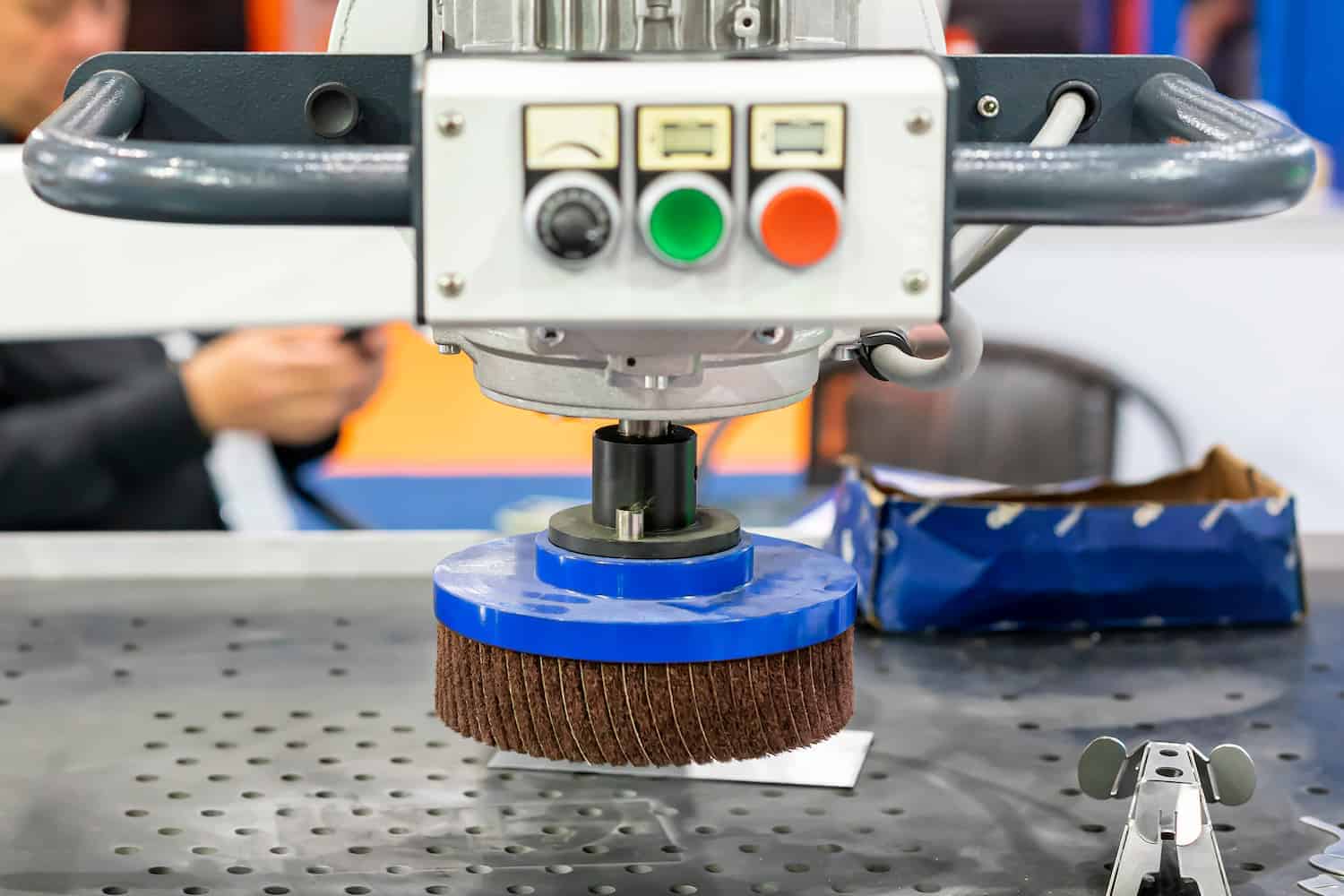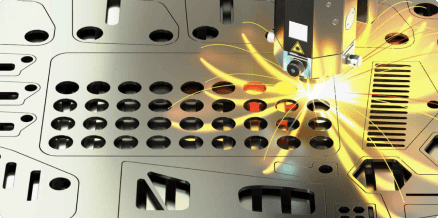A just machined sheet metal part has visible tool marks and potentially sharp edges and burrs. It not only affects the aesthetics of the part but also the tolerances. Post-processing operations also improve the strength and impart anti-corrosive properties to the metal. In order to have an improved part, it is always recommended to apply sheet metal finishes to the parts.
The Two Finishing Method Principles
The most common post-processing methods for sheet metal fabrication include plating and polishing. In the former, a layer is added to the surface and the latter involves the removal of material from the surface. Metal plating is also called coating while polishing is usually referred to as surface finishing.
Metal Plating or Coating for Sheet Metal
The general principle of metal coating involves the addition of a layer on top of the surface. The following processes explain this topic in detail.
Galvanising
Galvanising is a process mainly associated with steel. Commonly known as hot-dip galvanising is a process of immersing steel in a bath of molten zinc, thereby coating the steel with multiple layers of zinc-iron alloy and zinc metal.
It is because the zinc metallurgically reacts with iron in the steel and diffuses the coating perpendicular to the surface creating a uniform thick layer along the surface.

Passivation
Passivation is a post-processing process primarily involving stainless steel. Stainless steel mainly comprises iron, chromium and nickel. The anti-corrosion properties of stainless steel are provided by chromium in the alloy as it naturally produces a layer of chromium oxide on the surface while the free iron facilitates corrosion.
Passivation involves immersion of stainless steel in an acid bath (e.g. Nitric acid) which dissolves free iron and improves the strength of chromium oxide, thereby countering corrosion.

Anodising
Anodising is similar to passivation as it improves the thickness of the oxide layer thereby making the metal surface corrosion resistant. It is highly common for aluminium. It differs from passivation where instead of just dipping in acid, an electrolytic process is involved. Hence it is also called electrolytic passivation.
In anodising, aluminium alloy is dipped in a sulphuric acid electrolyte and used as an anode. When a cathode (inert material like stainless steel, nickel, carbon etc.) is placed and electricity is passed, oxygen flows to the anode and reacts forming an anodic oxide. This anodic oxide mostly contains aluminium oxide which protects against corrosion.
The electrolytes are usually:
- 10–15% solution sulphuric acid at 25℃ which produces an oxide layer of about 25µm/hr
- Mixture of oxalic and sulphuric acids at 30℃, producing about 30µm/hr
- 10% chromic acid operating at 38–42°C, producing about 15µm/hr
Anodising also imparts a coarse and grainy surface finish to the metal. It also facilitates the trapping of dye in the oxide layer, thereby giving a near-permanent colour.
Hard anodising
In hard anodising, thicker oxide coatings are formed (25-100µm). This is achieved as a result of performing electrolysis by using oxalic and sulphuric acid mixture at high concentrations and at the temperature of 0-10°C. The coatings are often grey to black in colour. The hardness is typically 500-900HV.
Chem-film
Chem-Film is also a process of aluminium passivation. Chem-film is applied by dipping, spraying or brushing the aluminium. It doesn’t affect the dimensions and can serve as a base for further organic coatings.
It can be applied to repair anodised surfaces. The resultant coating varies from colourless to yellow to tan in the spectrum. Hence, varying shades of yellow can be found on the chem-filmed metals.
Electroplating
Electroplating is a technique of plating one metal onto another by hydrolysis. Here, the cathode is the metal to be plated and the anode is sacrificial. For example, a sacrificial silver anode can plate the surface of a steel or aluminium cathode in hydrolysis. This process can impart strength and anti-corrosive properties to the metals.

Black Oxide
Black oxide process is referred to as chemical conversion coating. Unlike electroplating, the black oxide coating is produced by the chemical reaction between the iron content in the materials like aluminium or steel and the oxidising salt present in the black oxide solution.
The solutions are widely available and have catalysts, penetrators, activators and additives which take part in the reaction resulting in a black iron oxide layer, and magnetite (Fe3o4) formation on the substrate surface. The inception of wax or oil can also increase the anti-corrosion and friction reduction in the parts.
Black colour helps in the reflection of light thereby UV and infrared resistance.
Electroless Nickel Plating
Electroless nickel or nickel phosphorus plating involves the deposition of an even layer of nickel-phosphorus alloy on the top surface of the solid substrate, like aluminium or steel. The substrate is dipped into a water solution containing nickel salts and phosphorus-reducing agents.
Unlike electroplating, this procedure plates the substrate uniformly while the former suffers from uneven current density and resistance of the substrate.
Powder Coating
Powder coating involves free-flowing dry powder which is coated on a substrate. Unlike the normal liquid paint which utilises evaporating solvent, powder coating is applied electrostatically and cured under heat or UV light. The powder can be of thermoplastic or a thermoset polymer.
The finish is usually tougher and even compared to conventional coats. Metals like aluminium and steel can be efficiently coated with polymer powders.

Polishing or Surface Finishing for Sheet Metal
Bead Blasting
The bead blasting technique involves spraying a pressurised stream of tiny beads of media (plastic or glass) from a nozzle onto the surface of the part. This removes the burrs and imperfections, leaving a smooth finish. In addition, the end product resembles a uniform matte finish.
Bead blasting is done in a closed chamber. Glass bead blasting is more common for sheet metal parts. Since the surface is matte, it is ideal for painting and dying. Bead blasting before anodising is ideal surface preparation, creating a non-reflective surface. The recommended part size is 6-600 mm in both height and width. Smaller parts are hard to hold and tough to produce an even surface.
Tumbling
Tumbling is an inexpensive alternative to bead blasting where, instead of glass beads, abrasive ceramic media is present in a vibratory tumbler. The combination of water, media and vibratory motion helps in the reduction of burrs and imparts an even surface. It is suitable for surface preparation for any following operations like anodising and dying.
The metals undergoing tumbling must be thicker in order to withstand the vibrations and deformation. For stainless steel, the part should be at least 0.8 mm, for aluminium and non-ferrous, above 1 mm thickness is recommended.
Electropolish
Electropolishing is the opposite of electroplating. In the latter, the substrate is a cathode and the sacrificial anode imparts its ions to the cathode. Here, it is reversed where the substrate is an anode and its ions travel towards the cathode.
In this process, the micro peaks and valleys are levelled out. It is a very good technique for deburring and reducing surface roughness.
Sheet Metal Finishes Available at Xometry
Standard (as-cut) is the finish option with the fastest turnaround. Parts are left with visible tool marks and potentially sharp edges and burrs. They might have marks from the waterjet cutting, discolouration due to laser cutting or even tool marks from milling. These can be removed on request.
Sheet metal parts can have their aesthetics improved and mechanical and thermal properties increased with the help of various post-processing options. The table below sums up and compares the sheet metal finish available at Xometry.
| Finishing option | Suitable material(s) | Benefits |
| Galvanising | Stainless steel, steel | • Increases resistance to corrosion |
| Passivation | Stainless steel | • Increases the part’s resistance to corrosion |
| Anodising (orange, red, purple, gold, yellow, black, green, blue and clear anodising) |
Aluminium | • Gives a shiny aesthetic finish • Increases the part’s resistance to corrosion |
| Hard anodising (grey, clear, black, PTFE impregnated hard anodize*) |
Aluminium | • Increases surface hardness • High degree of water and corrosion resistance |
| Chem-film (gold, clear) |
Aluminium | • Improves corrosion resistance • Does not affect electrical conductivity |
| Electroplating (gold, silver and zinc plating) |
Aluminium, steel alloys | • Increases resistance to corrosion • Increases strength and aesthetics |
| Black oxide | Aluminium, steel | • Increases resistance to corrosion • Increases UV resistance |
| Electroless nickel plating | Aluminium, steel | • Improves the surface • Cost effective |
| Powder coating | Aluminium, steel | • Increases strength • Good base for dyeing |
| Tumbling | Aluminium, stainless steel | • Cost-effective • Even and shiny surface |
| Electropolish | Aluminium, stainless steel | • Even and shiny surface • Corrosion resistant and high weldability |
| Bead blasting | Aluminium, stainless steel | • Highly effective for even and smooth surface finish |
*PTFE or Teflon molecules are introduced into the controlled oxide preparation which gives a hard Teflon layer on the top along with oxide.
Source Sheet Metal Parts With Finishes at Xometry
Finishing is a very important operation for sheet metal processes. Both plating and polishing help each other in improving the quality of the surface and increase both the physical and mechanical properties of the part.
Xometry offers sheet metal services throughout Europe and our experienced team is always ready to help you. Upload your files to Xometry Instant Quoting Engine and get a quote in a matter of seconds for your sheet metal projects.
 Europe
Europe  Türkiye
Türkiye  United Kingdom
United Kingdom  Global
Global 

 Login with my Xometry account
Login with my Xometry account  0
0











 Download
Download
